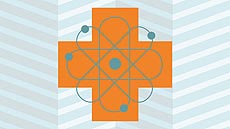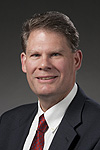|
Wednesday, Nov. 13
- Breakfast: breakfast strata
- Breakfast: ham, egg and cheese English muffin
- Grilled-chicken quesadilla
- Smart cuisine: herb and lemon fish
- Honey baked ham
- Italian antipasto panino
- Pasta bar
- Vegetarian harvest moon vegetable soup
- Texas-style chili
Wilson Hall Cafe menu |
|
Wednesday, Nov. 13
Lunch
- Herb roasted cornish hen
- Sage and onion stuffing cups
- Roasted broccoli
- Pumpkin pie with whipped cream
Friday, Nov. 15
Dinner
- Spinach and strawberry salad
- Grilled mahi mahi with roasted red-pepper sauce and cilantro pesto
- Green rice
- Sugar snap peas
- Coconut cake
Chez Leon menu
Call x3524 to make your reservation.
|
|
How particle physics can save your life
 |
From new medicines to cancer treatment, the tools of particle physics play an important role in hospitals around the world. Image: Sandbox Studio
|
The same particle physics technology used to understand the universe is also used to improve health and medicine. Accelerators and detectors play an important role in diagnosing disease, shrinking tumors and sterilizing medical equipment. Large-scale computing makes it possible to determine which potential new drugs are most likely to work before starting large-scale human trials. And particle-physics-trained scientists serve as medical physicists, making sure it all works as planned.
Sterilizing instruments and supplies
Particle physics technology can be used to disinfect syringes, bandages, scalpels, stethoscopes and other tools without damaging them. Medical equipment is sent through a series of small particle accelerators and bombarded with beams of electrons or X-rays. In a matter of seconds, the beams eradicate any surface microbes.
Distributed and grid computing
The World Wide Web is not the only computing advancement to come out of particle physics. In order to cope with the huge amount of data produced by experiments, particle physicists developed a network of grids allowing multiple users to share computing power and storage capacity. The grid concept has a number of uses in the medical field, including screening drug candidates to determine which ones are most likely to fight disease.
Simulation
Practice makes perfect, and when it comes to our health, the closer to perfect, the better. So some doctors and medical physicists are designing treatment plans using modeling tools developed for particle physics to predetermine the electromagnetic and nuclear interactions of particles with tissue. In radiation therapy, this software can help doctors understand what will happen when a beam of particles passes through a patient's body.
Semiconductors
In the heart of particle physics detectors around the world, hundreds of detectors made with silicon semiconductors splay out around particle collision points, tracking charged particles to create pictures of their paths. Physicians make use of this semiconductor technology in many medical devices, including semiconductor lasers. These discrete beams of high-intensity light are perfect for delicate operations like eye surgery.
Read more
—Kelly Izlar
|
Accelerator update, Nov. 11
Proton Source
AD personnel performed maintenance and tuning studies as needed.
Booster Neutrino Beamline
AD personnel worked on beam tuning, changed modes and began delivering beam through the Booster Neutrino Beamline to the MiniBooNE experiment.
Main Injector/NuMI
Between Nov. 4 and 11, the Main Injector provided 122 hours of proton beam to the NuMI target for the production of neutrinos for MINERvA, MINOS and NOvA. The machine delivered an integrated intensity of 5.84 x 1018 protons on target.
Recycler
AD personnel located a cotton wipe in the 308 section of the Recycler beam pipe. After removing it, they began the Recycler commissioning process.
Switchyard
AD personnel worked on extraction and beamline tuning.
Fixed-target area: Test Beam Facility
AD and ESH&Q personnel worked on foil calibrations to verify intensity monitor readings. Beam tuning for the experiments in the Fermilab Test Beam Facility continued as usual.
Fixed-target area: SeaQuest
Experts continued vacuum leak checks and beamline cleanup in preparation for the startup of the SeaQuest experiment at the end of the week. On Friday, Nov. 8, SeaQuest saw first beam, and tuneup commenced over the weekend. Experts also began investigating a problem with the segmented wire ion chamber in enclosure NM1 and ended up removing it for repair.
View the AD Operations Department schedule.
|
Fermilab to help plan District 181 science curriculum
From The Doings Hinsdale, Nov. 8, 2013
Hinsdale-Clarendon Hills Elementary District 181 will have some outside experts aboard when it establishes its Science Curriculum Committee next summer.
Kevin Russell, the district's assistant superintendent for learning, has been in contact with Fermilab representatives, who are interested in reaching out.
"Our science curriculum comes up for review next year," said Russell, the former principal at Walker School. "They have a teacher resource center at Fermilab, and they really want to work with schools. They said they're surprised they don't get more inquiries from schools in the area."
Read more
|
|
Fermilab's new counterintelligence partners
 |
|
Michael Weis
|
Michael Weis, DOE Fermi Site Office manager, wrote this column.
Tuesday was Computer Security Awareness Day at Fermilab, and I'd like to tell you about recent changes, brought about by sequestration, in the way DOE is handling cybersecurity and other security measures related to counterintelligence, also known as CI.
The DOE Chicago Counterintelligence Field Office closed on Oct. 1. The Argonne National Laboratory CI office has assumed counterintelligence coverage responsibilities for Fermilab, Ames Lab, New Brunswick Lab and DOE federal employees within the region.
Both the closed Chicago CI and the Argonne CI field offices are part of the Department of Energy's Office of Intelligence and Counterintelligence. Larry Collins, Argonne's Intelligence Analysis Division director and senior counterintelligence officer, assures me that Argonne CI has been working diligently since April to provide the requisite CI services to Fermilab. It has also been conducting reviews of Work for Others proposals, Memoranda of Understanding with foreign entities and the history of the CI mission at Fermilab for the last six months.
Fermilab employees are encouraged to contact the following individuals with any questions regarding CI matters: Larry Collins at 630-252-9919; Tom Stillman, lead counterintelligence officer, at 630-252-6191; Diana Naples, lead CI analyst, at 630-252-1239; and Steve Fuller, lead CI cyber-technical expert, at 630-252-6755.
|
ESH&Q weekly report, Nov. 12
This week's safety report, compiled by the Fermilab ESH&Q Section, contains no incidents.
Find the full report here.
|
House Science Subcommittee hearing on new DOE Office of Science bill
From FYI: The AIP Bulletin of Science Policy News, Nov. 8, 2013
Last week's hearing of the Subcommittee on Energy of the House Committee on Science, Space, and Technology had twin objectives. It offered the opportunity for subcommittee members, a senior official of the DOE Office of Science, and two other witnesses to describe the importance of the research that the Office supports. It also gave the members and witnesses a chance to offer first comments on a draft discussion bill to authorize programs and funding levels for the Office of Science in FY 2014 and FY 2015.
The hearing lasted 90-minutes and avoided the partisan divisions that characterized the House Science Committee's deliberations on a new NASA authorization bill. While there were disagreements about funding levels, the bill's two year span, and climate change research, they were low-key in nature and tone.
Read more
|
|